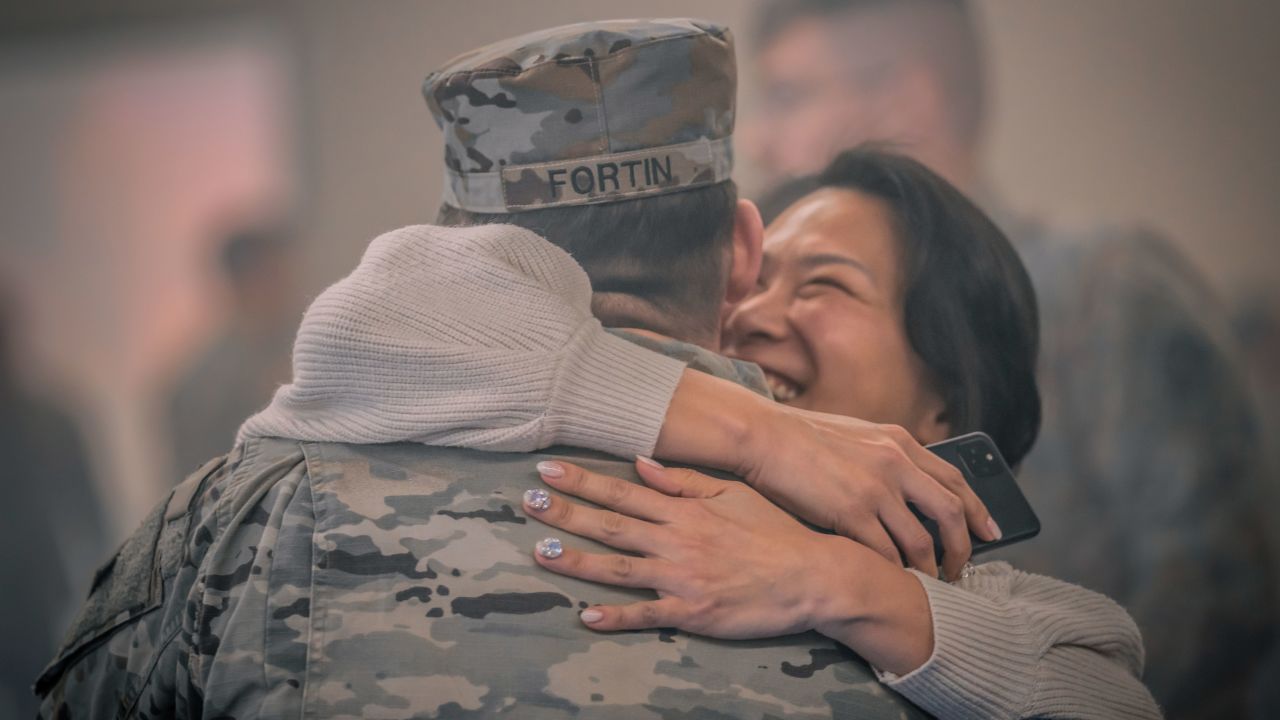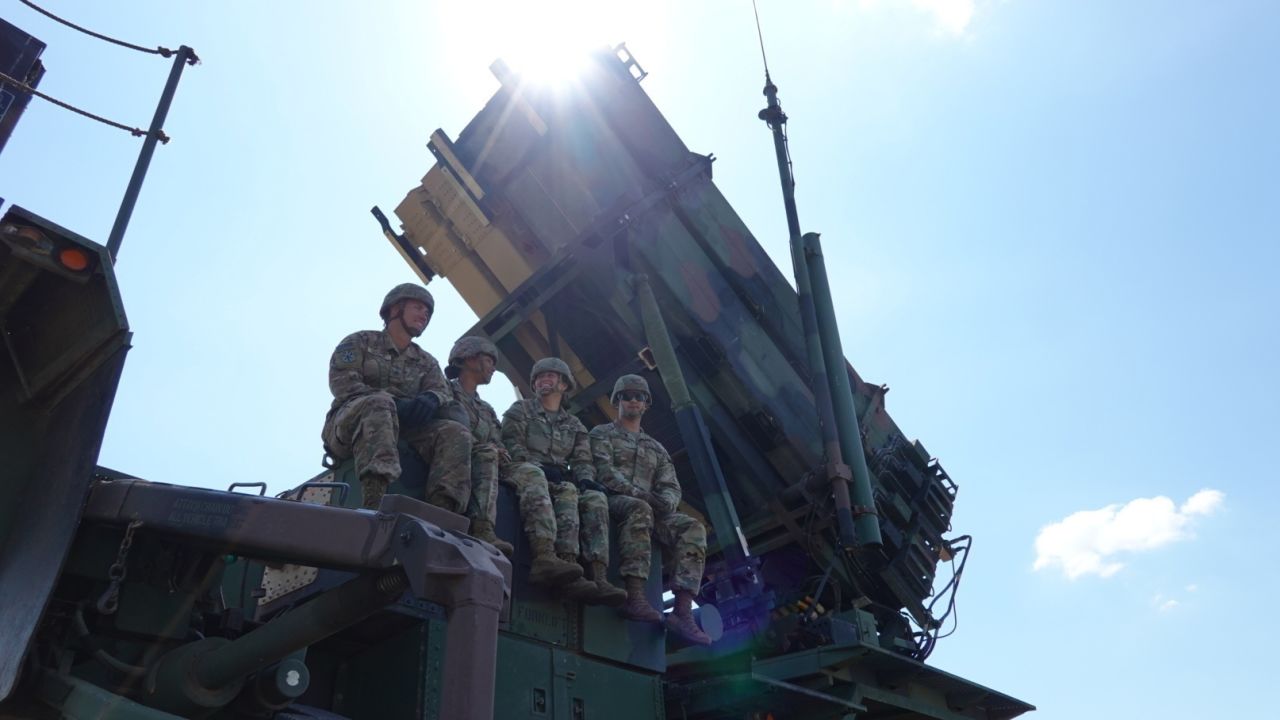Haley Britzky

Patriot missile batteries from the 5th Battalion, 7th Air Defense Artillery Regiment stand ready at sunset in Poland on April 10, 2022.Sgt. 1st Class Christopher Smith/U.S. Department of Defense
The US Army’s air defense units are among the most overworked in the US military, manning missile systems across the globe to provide around-the-clock deterrence against adversaries including North Korea, China, Iran and Russia.
In describing the problem to CNN, the Army’s most senior air defense officer, Lt. Gen. Dan Karbler, recounted something an Army sergeant told him recently: “Sir, it’s simple, pure math. We have more missions than we have air defense capability.”
As demands stack up with the war in Ukraine and amid looming concerns over a potential conflict with China, service leaders have been sounding the alarm that these critical missile defense units could be stretched too thin.
“It could get out of whack in a hurry if it’s not managed properly,” Maj. Gen. Brian Gibson, commander of the 94th Army Air and Missile Defense Command in Hawaii, told CNN.
The situation became so severe that in 2020, the service conducted a survey of air defense soldiers and families, and have recently been working to implement changes to offload some of the pressure those soldiers and families are feeling.
The Army is offering $47,500 enlistment bonuses to attract more candidates for certain air defense jobs, including operating Patriot missile batteries. It’s also embedded mental health specialists into air defense units around the world in an effort to address what has emerged as a troubling side-effect of manning the front lines of America’s missile defense systems: burnout.
“Right now, the Army has directed that we put behavioral health specialists in the formations,” said Karbler, who is commander of the Army’s Space and Missile Defense Command. “We have them there, and they will become a permanent part of those organizations.”
Near constant deployment
The Army’s air defense branch is among the most frequently deployed branches of the service, with almost 60% of its total force deployed at any one time. On average, air defense soldiers were found to have less than a year at home after a year-long deployment, when ideally they should have two to three years at home after a year away. The Army has since brought that up to two years at home for every one-year deployment – Defense Secretary Lloyd Austin’s “red line,” according to Karbler.
Since Russia invaded Ukraine last year, US air defense soldiers stationed in Europe have had to deploy with just hours’ notice to protect NATO’s Eastern flank and assist in training Ukraine. Meanwhile in the Pacific, the US military is increasing its presence in the region to prepare for a possible future conflict with China – while also maintaining its deterrence of North Korea. All of this is in addition to an ongoing mission in the Middle East, though the Pentagon has reduced some commitments in the region as partners have increased their own air defense capabilities.
In describing the problem to CNN, one senior Army air defense officer, who spoke on condition of anonymity in order to speak freely, “We have been overworked and undermanned.”

US Army air defenders with Bravo Battery, 5th Battalion, 7th Air Defense Artillery Regiment, 10th Army Air Missile Defense Command, reunite with family and friends after a year-long deploymentPfc. Yesenia Cadavid/U.S. Department of Defense
A long with embedding mental health specialists, the Army is also working to stand up entirely new air defense units over the next few years.
Leaders are also increasingly focused on communicating with families early and often to help mitigate the unpredictable nature of the job, especially when the duration of deployments are extended out. One noncommissioned officer who deployed to the Eastern flank at the start of Russia’s invasion, Sgt. 1st Class Graham Kimmel, said he and his commander organized a newsletter for families, through which they shared photos of their deployed soldiers and information they could share so families felt up to date.
“We said they were going for six months, and now all of a sudden they got extended for nine months, or they’re going for nine months and got extended for 12 months, and in some cases got extended for longer than a year,” Karbler said of air defense forces. “That unpredictability really, really affected the soldiers and the families,” he added, “and was a significant contributor to stress on the force.”
No signs of slowing in the Pacific
In the Pacific, the strain is often felt by the sheer size of the region and the time and resources it takes to get from one place to another. In 2023 alone, US Army Pacific was expected to participate in 24 military exercises which are crucial to the US’ efforts in building relationships in the region, learning from one another, and strengthening partnerships in the chance that conflict does come to the Pacific.
Gibson explained that it can take a “massive amount of time” to get soldiers and equipment from place to place in the Pacific for exercises, and that there is “growing momentum” from partners in the region to “expand our scope and pace of exercises and operating together.”
That’s in addition to units often being ordered to a higher state of readiness because of activity in the region, like when North Korea launches a missile.
“I don’t see, today, any reduction in what potential adversaries are doing in the theater,” Gibson said. “I think there’s a real chance that it only continues to increase from actions that predominantly China and North Korea conduct. But Russia also has parts to play pretty significantly in this theater, especially in the maritime and air domain.”
‘Business is good for air defense’
Brig. Gen. Maurice Barnett, commander of the 10th Army Air and Missile Defense Command in Europe, put it simply: “Unfortunately, business is good for air defense.”
Indeed, the need for a strong air defense has been on display for the world to see in Europe as Ukraine has worked to thwart attacks by the Russian military since last February.
And for the US soldiers tasked with providing defense of partners, as well as training Ukrainians to operate their own air defense systems, the stakes couldn’t be higher.
Master Sgt. Carlos Retana, a Patriot Master Gunner, led the US Patriot training for Ukrainians in Europe after they trained at Fort Sill, Oklahoma. The training was unlike anything he’d seen in his 23 years in the Army, Retana told CNN – not only because of the Ukrainian troops themselves, who ranged drastically in age and military experience from before the war, but also the very real consequences hanging over the training as a motivator for US troops to teach their Ukrainian counterparts everything they know.
Retana said ultimately, the US trainers were “praying that what we did was sufficient” in teaching the Ukrainians how to operate the Patriot and sending them back to the front lines.
“At the very end, it was bittersweet – it was happy that the training was complete, and that [the Ukrainians] were successful,” Retana said. “But it was also a very worrisome and heavy burden to think they’re headed into the wolf’s den … to go fight.”

Servicemembers assinged to Bravo Battery, 5th Battalion, 7th Air Defense Artillery, 10th Army Air Missile Defense Command, rest on a Patriot missile launcher on Aug. 9 in Slovakia.2nd Lt. Emily Park/U.S. Department of Defense
Being that close to the Ukrainians’ mission reaffirmed how critical air defense is to the Americans conducting the training, Retana said, and made the increased demands on them worth it.
“It motivates people because it gives us meaning … You’re willing to go through a lot more when you believe that what you’re doing is meaningful.”
The demand of that mission has resulted in a decrease in how many exercises the US is participating in with partners in Europe, Barnett said, taking the total number from 18 to 12 this year. He added that the Army has to “look at creative ways to meet the mission requirements” – because at the end of the day, the mission requirements aren’t slowing down.
“Our number one priority, of course, is taking care of our people,” Barnett said. “But that’s only supplemented by we have a mission to accomplish here. And I don’t think the American people, nor our European allies, will take no as an answer.”
No comments:
Post a Comment